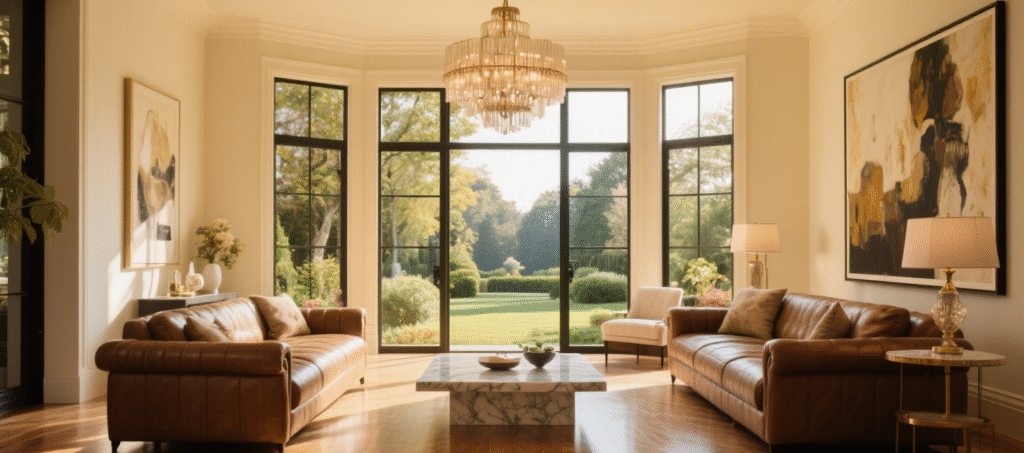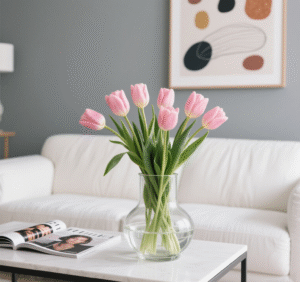This post may contain affiliate links which means we may receive a commission at no cost to you, if you make a purchase through a link. Please see our full disclosure for further information.
Designing a living room that looks good, feels cozy, and works well can be hard. From hanging your TV too high to not layering furniture, here are some common living room design mistakes. Plus, I’ll share tips and tricks to fix them.
Layout Problems
Pushing Furniture Against the Walls
Pushing all your furniture against the walls might seem like a good way to save space. But, it’s not always the best idea. You don’t want your living room to look empty.
Start by sketching your room. You can use pen and paper or software like Rayon. Rayon helps you draw floor plans quickly and easily online. It has many pre-made furniture pieces that you can drag and drop into your plan. You can also change the style of the plan to match your taste.
Before you arrange the room, think about how you want to use it. What will be the main focus of the room? A fireplace? A window with a view? Built-in shelves? Or a gallery wall?
Start with a big piece like a sofa. Then, add smaller pieces like armchairs and a coffee table to create a cozy seating area. You don’t want people to have to shout to talk to each other.
Blocking Walkways
Another common mistake is not thinking about how people will walk through the room. Watch how people move from one side of the room to the other. Also, think about how people will get to doors.
Leave about 36 inches for main walkways, or 24 inches in a smaller room. Arrange your furniture so people don’t have to squeeze past things. Make sure furniture doesn’t block doors. Think about how the door opens so furniture doesn’t get in the way.
TV Troubles
Mounting the TV Too High
Mounting your TV too high can make your living room look bad and feel uncomfortable. It makes people strain their necks to watch TV. It also takes attention away from other design elements in the room.
If you have to mount your TV high because of a fireplace, try a bracket that lets you pull the TV down. Or, get a frame TV that blends in with the room. If you watch TV a lot, try to find a way to keep the TV at eye level when you’re sitting down.
If you have enough wall space, put the TV on the wall next to the fireplace. In a bigger living room, you can put the TV and fireplace on opposite walls. This will make the room look better and feel more relaxing.
Hanging Art Incorrectly
Like TVs, hanging artworks too high is a mistake. Hang them at eye level. Eye level is about 57 to 60 inches from the center of the artwork to the floor. This is what museums do. But, you can change it if your family is taller or shorter than average.
If you hang art above a piece of furniture, put it about 6 to 10 inches above the furniture. This connects the art to the furniture. You can hang it higher if you want, depending on the ceiling height.
Size and Scale
Disproportionate Furniture
Scale is the overall size of an object or space. Proportion is how the sizes of different things in a room relate to each other. Many people buy furniture that is too small or too big. This makes the room look out of balance.
Big furniture in a small living room can make it feel cramped. Small furniture can make the room look empty. You need to find the right balance so everything looks good together.
One tip is to follow the Golden Ratio, or 2/3 rule. This means making sure the sizes of things in your room are proportionate and look good together.
- A sofa should be about 2/3 the width of the wall behind it.
- A coffee table should be about 2/3 the width of your sofa.
- Art above the sofa should be about 2/3 the width of your sofa.
- A TV should be about 2/3 to 80% the width of the furniture under it.
These are just guidelines to get you started. But, remember that you don’t always have to follow them exactly.
Lighting
Relying on One Light Source
Lighting is key to a well-designed space. If the lighting is bad, the room will look dull. This often happens when people only use one overhead light.
You need a mix of ambient, task, and accent lighting. This means having ceiling lights, table lamps, and floor lamps. Also, add decorative lights to highlight architectural details or artworks.
Mix different light sources in different places and at different heights. Pay attention to direct and indirect light. Indirect light reduces harsh shadows.
When choosing a lamp or light, think about what it will be used for. A lamp with a focused beam is good for reading. A lamp with a shade is better for lighting a dark corner.
Ignoring Light Temperature
Also, think about the temperature of your light bulbs. I recommend 2700 to 4,000 Kelvin for the living room. I like it warmer at night.
If you can, use smart bulbs. These let you change the temperature and brightness. This helps you have the perfect lighting all the time.
Style
Matching Furniture Sets
Matching furniture sets might seem easy. But, they can make your living room look boring. Instead, mix and match new and vintage pieces. Use furniture of different styles. Play with shapes and colors. Add personal touches like books and photos.
This makes the room feel more unique and welcoming. It also shows your personal style.
When mixing furniture, look for things that have something in common. This could be the material, style, or color. For example, a modern dining table and vintage chairs might look good together if they are made of the same wood.
Repetition is important so things look intentional. But, you also want variety and contrast so the room doesn’t feel flat.
Don’t rush the process. You don’t have to buy everything at once. Take time to find pieces that you like and will use.
Not Layering Decor
Have you ever been in a living room that feels flat and boring? This is often because it lacks layering. You need to add different textures, materials, shapes, tones, and sizes for depth and interest.
Think about how you can contrast different things. Hard and soft? Straight and curved? Angular and rounded? Dark and light? Matte and glossy? Big and small?
For example, designers often put a rough vase on a smooth countertop. You can also layer by bringing together furniture and objects from different styles. For example, you could put antique chairs with a modern dining table.
You can also layer with color. Contrast between dark and light colors adds visual interest. Indoor plants are also great. They have an organic shape, different colors, and texture. Plus, they bring nature inside.
Remember to pay attention to height. If all your pieces are the same height, it will look off. Tall lamps, plants, artwork, and curtains can add height.
Want to create a beautiful home? Download a free decorating checklist to help improve the look and feel of your home!
Lifestyle
Not Considering Lifestyle
Tailor your living room design to fit your lifestyle. This makes the space not only beautiful but also functional and enjoyable.
Before you buy anything, think about your lifestyle and needs. Ask yourself:
- How will I use this furniture?
- Does my furniture need to be kid-friendly or pet-friendly?
- What materials will look good in my room?
- Do I need more storage?
- Will this piece block traffic flow?
This makes sure your purchases match your taste and will last.
Prioritizing Looks Over Comfort
Everyone values things differently. Some people spend a lot on an armchair. Others spend a lot on a desk. Not every piece in your home needs to be expensive.
Don’t choose furniture only because you like how it looks. It also has to work with your lifestyle and be comfortable.
Top 10 Exclusive Luxury Furniture Brands – Inspirations
Top 10 World’s Luxury Interior Furniture Brands
Top 15 Cool And Unique Hotels In London
Uncover further inspiration in our blog.















